AI-Driven Threat Detection: What’s New in 2025?
Introduction
In the rapidly evolving landscape of cybersecurity, Artificial Intelligence (AI) has emerged as a game-changer in detecting and mitigating threats. AI-powered threat detection solutions have been instrumental in identifying and neutralizing sophisticated attacks that were previously difficult to detect using traditional methods. In this article, we’ll dive into the latest developments in AI-driven threat detection and explore what’s new in 2025.
Evolution of AI-Driven Threat Detection
In recent years, AI-powered threat detection has made significant strides in improving the effectiveness of security solutions. The early adoption of machine learning (ML) algorithms enabled systems to learn from past attacks and adapt to new patterns. However, the pace of innovation has accelerated, with the introduction of more advanced techniques such as:
- Deep Learning: Incorporating deep learning models has significantly enhanced AI-driven threat detection capabilities. These models can analyze large volumes of data, recognizing complex patterns that were previously undetectable.
- Graph-Based Analysis: Graph-based analysis has become a crucial component in AI-powered threat detection. This approach enables the visualization and analysis of relationships between different elements, such as users, devices, and network connections.
New Developments in 2025
As we enter 2025, AI-driven threat detection is poised to revolutionize the cybersecurity landscape with several key advancements:
- Autonomous Incident Response: AI-powered systems will be able to autonomously respond to detected threats, reducing the burden on security teams and minimizing the impact of attacks.
- Predictive Analytics: Advanced predictive analytics will enable AI-powered systems to anticipate potential threats based on historical patterns and real-time data. This proactive approach will empower security teams to take preventative measures before attacks occur.
- Human-Machine Collaboration: The integration of human intuition with AI-driven threat detection will lead to more effective and efficient incident response. AI will analyze large volumes of data, while human analysts provide context and expertise.
Applications in 2025
The benefits of AI-driven threat detection will be felt across various industries and use cases:
- Cloud Security: Cloud-based services will rely heavily on AI-powered threat detection to safeguard against the increasing number of cloud-based attacks.
- Industrial Control Systems (ICS): AI-driven threat detection will play a critical role in protecting ICS, ensuring the integrity and reliability of industrial operations.
- Internet of Things (IoT): As IoT devices become increasingly prevalent, AI-powered threat detection will be essential in detecting and mitigating targeted attacks on these connected devices.
Challenges and Limitations
Despite the significant advancements in AI-driven threat detection, several challenges and limitations remain:
- Data Quality: The quality and reliability of data used to train AI models are crucial. Poor-quality data can lead to inaccurate predictions and ineffective threat detection.
- Explainability: As AI-powered systems become more autonomous, there is a growing need for transparency and explainability in their decision-making processes.
- Bias: AI algorithms can inherit biases from the data they were trained on, which can have serious consequences in high-stakes security applications.
Conclusion
As we enter 2025, AI-driven threat detection has come a long way in revolutionizing cybersecurity. The introduction of autonomous incident response, predictive analytics, and human-machine collaboration will further enhance the effectiveness of these solutions. While challenges remain, the benefits of AI-powered threat detection far outweigh the limitations. As the landscape continues to evolve, it’s essential for organizations to stay ahead of the curve by investing in AI-driven threat detection technologies that can help them stay one step ahead of emerging threats.



